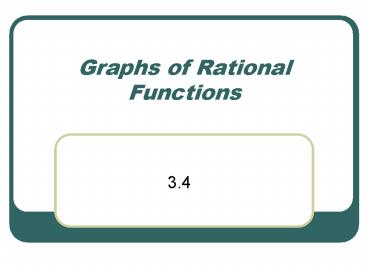Graphs of Rational Functions - PowerPoint PPT Presentation
1 / 13
Title:
Graphs of Rational Functions
Description:
7. Graph the function on the calculator. 8. Use the results above to graph the equation by hand. ... Simplify the terms and then factor. Draw a number line. ... – PowerPoint PPT presentation
Number of Views:33
Avg rating:3.0/5.0
Title: Graphs of Rational Functions
1
Graphs of Rational Functions
- 3.4
2
Steps for Graphing a Rational Function
- 1. Find the Domain.
- set the denominator to zero, then all reals
except those numbers. - 2. Find the intercepts.
- To find the x intercepts, set y to zero. Y
will be zero when the numerator is zero, so set
to zero and solve. To find the y-intercepts, set
x to zero and solve.
3
Steps for Graphing a Rational Function Continued
- 3. Test whether the graph is symmetric with
respect to the y-axis or origin. - Originplug in x for x and see if the new
function is the opposite of the old. Or if (x,y)
is on graph, then (-x,-y) is on graph. - Y-axisplug in x for x and see if the new
function is the same as the old. Or if (x,y) is
on the graph, then (-x,y) is on the graph. - 4. Find the vertical asymptotes.
- Numbers that make the denominator zero, but not
the numerator.
4
Steps for Graphing a Rational Function Continued
- 5. Find the horizontal and oblique asymptotes.
- If the degree of the numerator the degree of
the denominator, then the HA is the coefficients
of the highest degree terms. - If the degree of the numerator is lower than
the degree of the denominator, then the HA is
zero. - If the degree of the numerator is higher than
the degree of the denominator, then there is no
HA. - 6. Find the oblique asymptotes.
- Occur only when the degree of the numerator
is one more than the degree of the denominator.
5
Steps for Graphing a Rational Function Continued
- 7. Graph the function on the calculator.
- 8. Use the results above to graph the equation
by hand.
6
Polynomial and Rational Inequalities
- 3.5
7
Solving Polynomial Inequalities
- Put all terms on the left side and zero on the
other. - Simplify the terms and then factor.
- Draw a number line.
- Plot the zeroes on the number line.
8
Solving Polynomial Inequalities
- This divides the number line up into sections.
Plug a number from each section into the original
expression. - If the answer is positive put a plus sign in that
section, otherwise put a minus sign. - Choose the intervals with minus signs if the
inequality is a less than. Choose the positive
intervals if the inequality is a greater than.
Include the zeroes if the less than or greater
than includes an equal sign.
9
Solving Rational Inequalities Algebraically
- Rearrange the terms so that 0 is on the right
side. - Get a single fraction on the left, by creating a
common denominator and adding the algebraic
fractions. - Find the zeros of f by setting the numerator
equal to zero. - Find the values at which f is undefined by
setting the denominator equal to zero. (or
negatives under a square root)
10
Solving Rational Inequalities Algebraically
- Draw a number line and plot the zeros and the
values that make the function undefined. - Select a number in each interval and plug the
number into the original expression. If the
result is positive, then put pluses in that
section, otherwise put minuses.
11
Solving Rational Inequalities Algebraically
- Choose the negative intervals if the inequality
is a less than. Choose the positive intervals if
the inequality is a greater than. Include the
zeros(not the undefined) if the less than or
greater than includes an equal sign.
12
Solving Rational Inequalities Graphically
- Put the left side of the inequality in y1 making
sure that the entire numerator and denominator
are surrounded by parenthesis in a fraction. - Put the right side in y2.
- Use 2nd Calc Intersect to find where the graphs
intersect. - Plot these points on a number line.
13
Solving Rational Inequalities Graphically
- Place pluses in the sections where the graph on
the left is lt, gt,, or (depending on the sign
in the original problem) the graph on the right. - Write these sections in interval notation.































